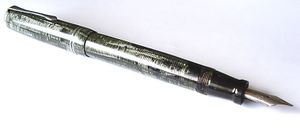Olo
| Olo |
|---|
| Brand pages |
| Brand advertising |
| Brand photos |
The Olo began as a sub-brand of Aurora in 1929, more or less simultaneously with the sister ASCO and with the release of Duplex celluloid model. The Olo brand appears to have been created to address the the medium and low segment of the fountain pen market, to complement the production of first tier models marked Aurora with lower price (and obviously less valuable) but always of good quality fountain pens. But the trademark was actually recorded (Reg. Gen. N. 41031) in 1929 for something totally different: milk, tea, coffee and surrogates, edible oils and fats, ..., lace, embroidery , felt, paper, paperboard, paper for upholstery, etc..
In commercial diversification strategy implemented by Aurora initially the Olo brand was completely independent, marketed through an extensive network of retail outlets other than ordinary stationers. For this reason, at the beginning of the brand history there was no reference to the parent company nor on the pens nor in related documents; the manufacturer was called Fabbrica di Penne a Serbatoio Olo and as company address was used a post office box in Turin.
Questo cambiò solo dopo la metà degli anni '30, quando il ruolo di sottomarca dell'Aurora divenne ufficialmente riconosciuto con la comparsa delle penne Olo nei cataloghi dell'azienda madre, proposte sempre come penne di fascia inferiore, ma con le solite caratteristiche di affidabilità e robustezza.
There is no precise dating of the Olo models, although usually you can take as a reference the corresponding modelsof the Aurora production of which they were a kind of cheap version; they are easily recognizable by clips shapes and materials entirely similar to those of the respective Aurora models.
First Olo models were safeties similar to R.A.3 (with clip) and R.A.0 (with ring), however, marked with the Olo logo (an ellipsoid squared with the OLO inscription inside) both on the nib and on the pen body and on the cap top. These were produced also in laminated gold overlays (marked 18 KR) always in the two previous measures, respectively called Type 3 and Type 0, and with two filling systems: safety and button filler, the latter resumed shapes and clip of the A.R.A. 15, even if the decorations used for the overlay are different from those of the Aurora models.

These first pens were followed by Flat top models, very similar to Parker Duofold, also produced in two sizes and in black and colored celluloid. These pens are characterized by a rather large metal ring on the cap and the OLO logo engraved both on the body near the bottom of the pen and on the nib section. These models were created in parallel to the introduction of the Duplex for which can be considered the economic version.
Seguendo i cambiamenti della produzione Aurora anche i modelli della Olo vennero rinnovati nella prima metà degli anni '30, con l'introduzione della Olo Lusso, prodotta in due misure, grande e media, con la stessa clip della Superna fissata sul cappuccio con una testina metallica dotata di un tassello a vite. La penna era realizzata in celluloide tornita dal pieno nei colori marmorizzati e a linee incrociate dei modelli Aurora dello stesso periodo e prodotta sia con finiture cromate che dorate. Il logo OLO era riportato o sulla sezione o sul corpo.
Nella seconda metà degli anni '30 vennero poi introdotti i modelli Olo F ed Olo Gamma, la prima era una penna sfaccettata, che si rifaceva all'analoga versione della Novum. la seconda una penna di linee più diritte, con un fondello con una copertura di metallo. Entrambe prevedevano l'abbinamento di matite meccaniche.
Negli anni '40 la produzione venne rivista, e venne utilizzata una nuova clip scalettata, non presente sui modelli marcati Aurora, ma utilizzata dall'azienda in altre produzioni economiche. Inoltre con l'introduzione nel 1938 dei pennini in Platiridio anche sulle Olo vennero montati pennini in acciaio o in acciaio placcato oro, marcati OLO, che oltre al logo con l'ellissoide squadrato riportano anche l'anno di produzione.
In questa fattura del 1941, viene citato un modello denominato Olo Flexor, prodotto almeno nella misura grande e media. Non è chiaro a quale modello si faccia riferimento.
La produzione di stilografiche a marchio Olo venne sostanzialmente abbandonata nel dopoguerra.
Riferimenti esterni
- nessuno per ora
